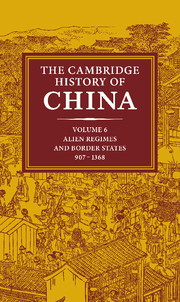Book contents
- Frontmatter
- Introduction
- 1 The Liao
- 2 The Hsi Hsia
- 3 The Chin dynasty
- 4 The rise of the Mongolian empire and Mongolian rule in north China
- 5 The reign of Khubilai khan
- 6 Mid-Yüan politics
- 7 Shun-ti and the end of Yüan rule in China
- 8 The Yüan government and society
- 9 Chinese society under Mongol rule, 1215–1368
- Bibliographical essays
- Bibliography
- Glossary-Index
- MAP 7. The Liao empire, ca. 1045
- MAP 12. The Hsi Hsia state, IIII
- Map 17. The Chin empire
- MAP 32. The Yüan empire">
- References
6 - Mid-Yüan politics
Published online by Cambridge University Press: 28 March 2008
- Frontmatter
- Introduction
- 1 The Liao
- 2 The Hsi Hsia
- 3 The Chin dynasty
- 4 The rise of the Mongolian empire and Mongolian rule in north China
- 5 The reign of Khubilai khan
- 6 Mid-Yüan politics
- 7 Shun-ti and the end of Yüan rule in China
- 8 The Yüan government and society
- 9 Chinese society under Mongol rule, 1215–1368
- Bibliographical essays
- Bibliography
- Glossary-Index
- MAP 7. The Liao empire, ca. 1045
- MAP 12. The Hsi Hsia state, IIII
- Map 17. The Chin empire
- MAP 32. The Yüan empire">
- References
Summary
INTRODUCTION
“Mid-Yüan” refers to the period between the death of the great dynastic founder, Khubilai khan (Emperor Shih-tsu, 1260–94), in 1924 and the accession of the last Yüan monarch, Toghön Temür khaghan (Emperor Shun-ti, r. 1333–68), in 1333. During these thirty-nine years, nine khaghans ascended the throne in quick succession, resulting in frequent bureaucratic turnovers and reversals of state policies. It was, therefore, a politically volatile and turbulent period, the events of which gradually but steadily emasculated the great and powerful empire left behind by Khubilai and paved the way for the downfall of the dynasty under Toghōn Temür.
The mid-Yüan khaghans inherited from Khubilai not only a great empire but also its multifarious problems. Khubilai had successfully transferred to China the center of gravity of the previously steppe-based Yeke Mongghol Ulus or “Great Mongolian Nation” and made the Yüan the first dynasty of conquest to rule the whole of China as well as the Inner Asian steppes. He had further provided his far-flung multiracial and multicultural empire with a workable institutional framework by synthesizing Chinese and Inner Asian systems and adorning it with the symbols of legitimacy drawn from Mongolian, Chinese, and Buddhist sources. Because of all this, Khubilai was subsequently regarded by his heirs as the most revered dynastic founder and ancestor whose mantle should be strictly preserved. The problems left by Khubilai to his heirs, nevertheless, were as great and complex as the empire itself.
Fundamentally, the position of the Yüan state in both China and the broader Mongolian empire needed to be carefully reconsidered and defined, and further adjustments made accordingly.
Keywords
- Type
- Chapter
- Information
- The Cambridge History of China , pp. 490 - 560Publisher: Cambridge University PressPrint publication year: 1994
References
- 5
- Cited by



